Exploring Cultural Diversity: A Case Study of Quadrant Recruitment
VerifiedAdded on 2023/01/19
|21
|4717
|33
Report
AI Summary
This report examines the benefits and potential problems of cultural diversity within Quadrant Recruitment, focusing on both individual and organizational perspectives. The literature review explores existing research on the advantages of a diverse workforce, such as increased creativity and productivity, while also addressing challenges like language barriers and differing professional etiquette. The methodology section justifies the use of primary research, specifically questionnaires, to gather data from employees. The report details the sampling process, including population, sampling method (convenience sampling), and sample size. The questionnaire design, with questions addressing equal opportunities, impact on performance, and training programs, is also presented. The results section analyzes the data collected through the questionnaire to identify key findings and insights regarding cultural diversity at Quadrant Recruitment. The conclusion summarizes the main points and offers recommendations for managing and enhancing cultural diversity within the company. The report provides a comprehensive analysis of cultural diversity in the workplace, offering valuable insights for Quadrant Recruitment and similar organizations.
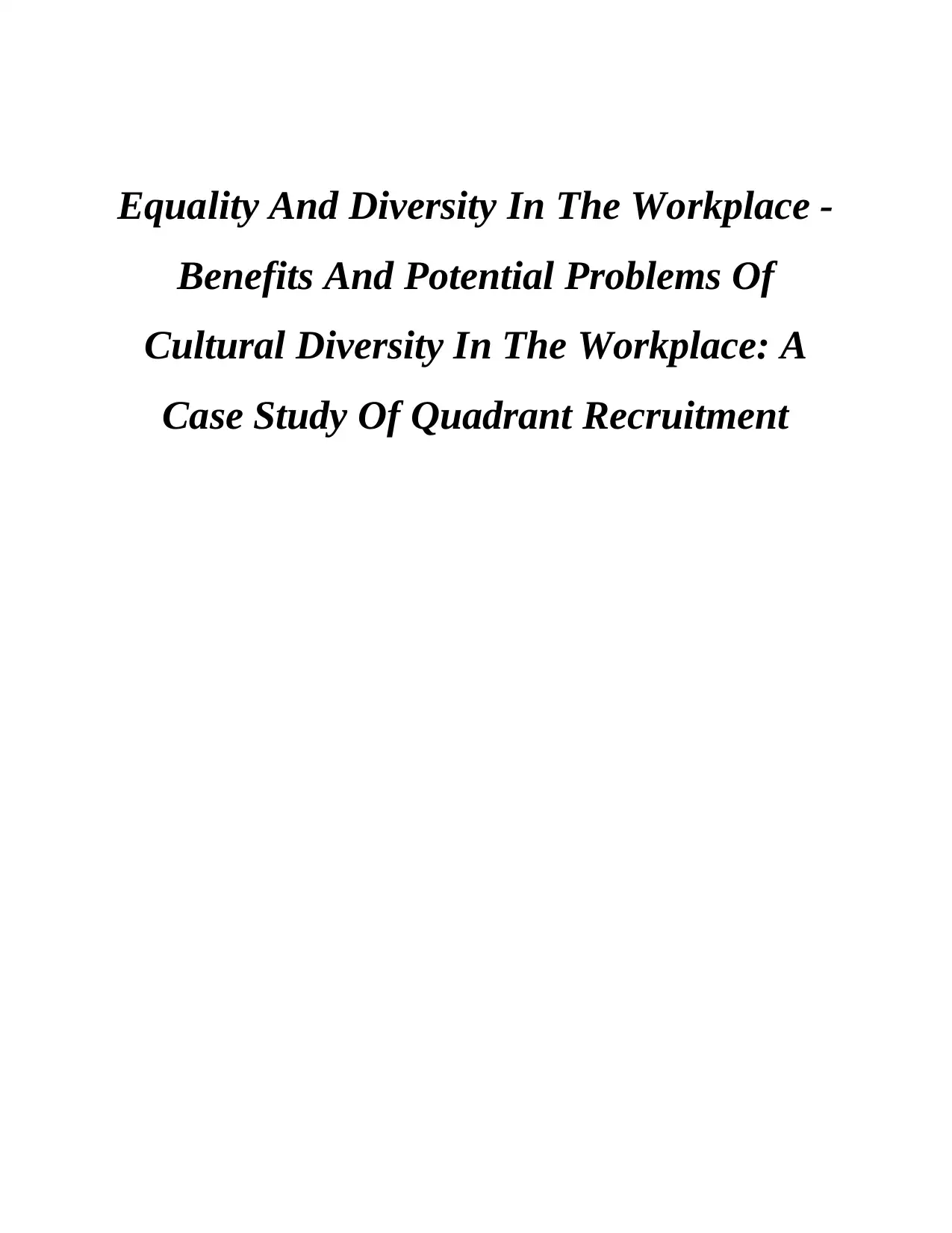
Equality And Diversity In The Workplace -
Benefits And Potential Problems Of
Cultural Diversity In The Workplace: A
Case Study Of Quadrant Recruitment
Benefits And Potential Problems Of
Cultural Diversity In The Workplace: A
Case Study Of Quadrant Recruitment
Paraphrase This Document
Need a fresh take? Get an instant paraphrase of this document with our AI Paraphraser
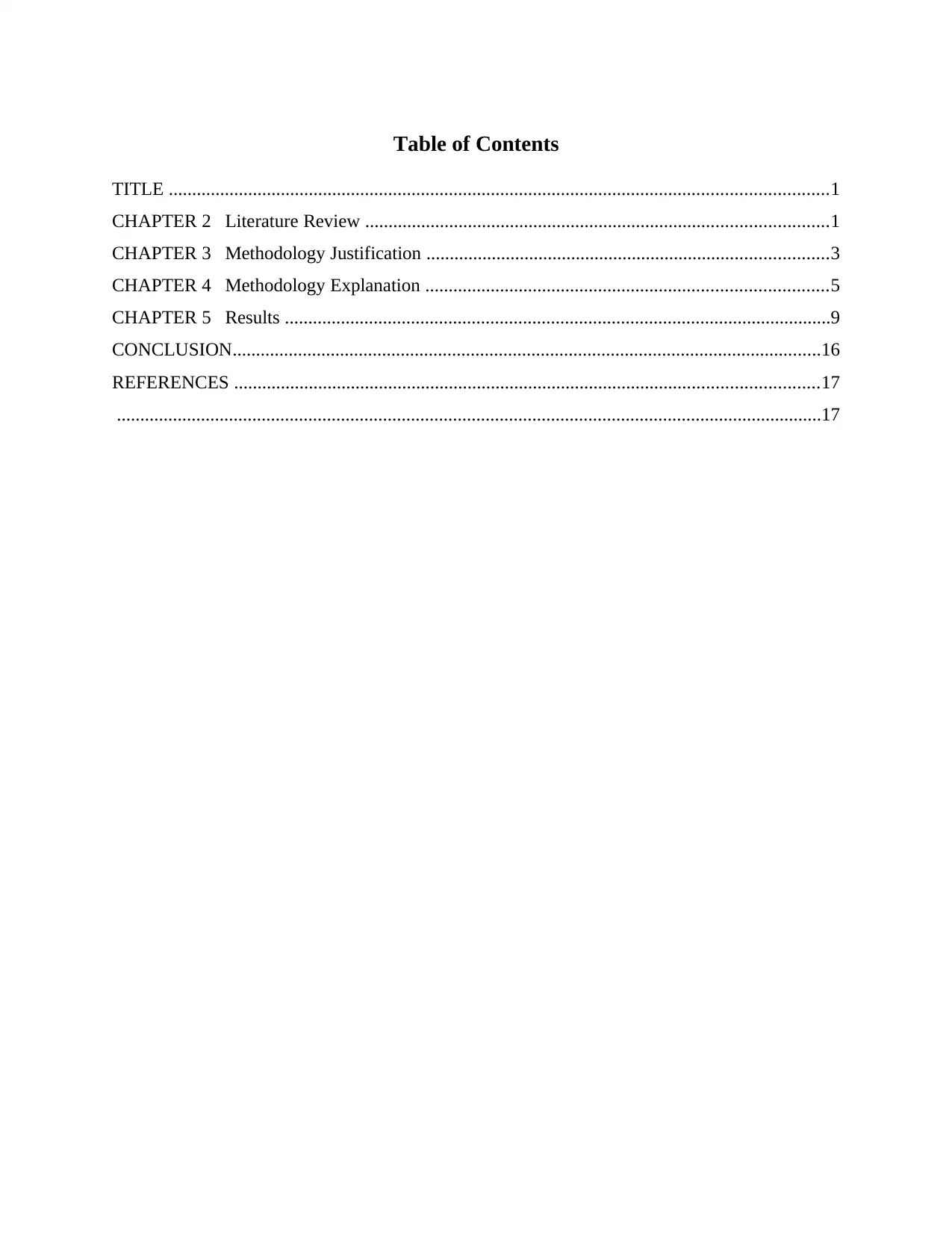
Table of Contents
TITLE .............................................................................................................................................1
CHAPTER 2 Literature Review ...................................................................................................1
CHAPTER 3 Methodology Justification ......................................................................................3
CHAPTER 4 Methodology Explanation ......................................................................................5
CHAPTER 5 Results .....................................................................................................................9
CONCLUSION..............................................................................................................................16
REFERENCES .............................................................................................................................17
.......................................................................................................................................................17
TITLE .............................................................................................................................................1
CHAPTER 2 Literature Review ...................................................................................................1
CHAPTER 3 Methodology Justification ......................................................................................3
CHAPTER 4 Methodology Explanation ......................................................................................5
CHAPTER 5 Results .....................................................................................................................9
CONCLUSION..............................................................................................................................16
REFERENCES .............................................................................................................................17
.......................................................................................................................................................17
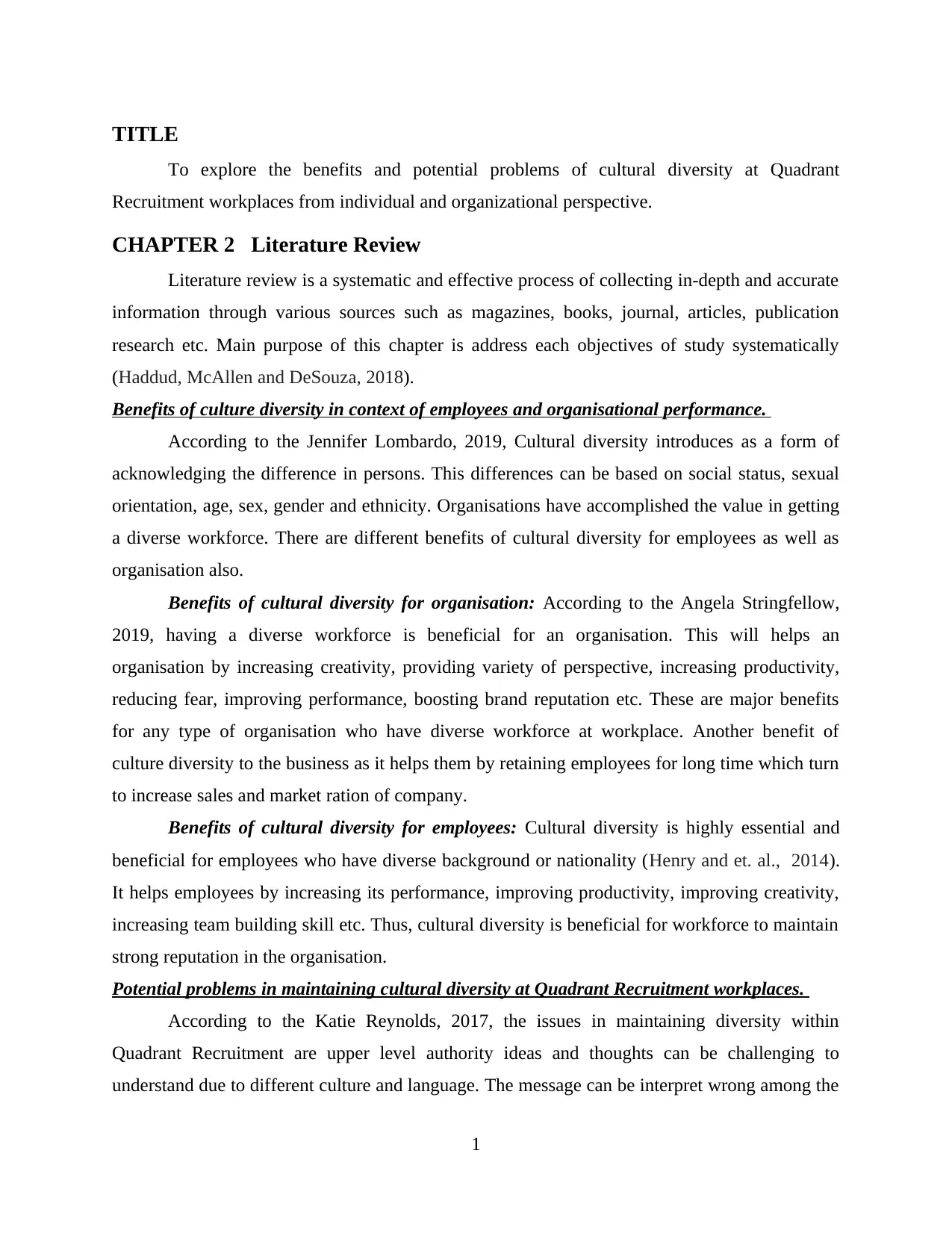
TITLE
To explore the benefits and potential problems of cultural diversity at Quadrant
Recruitment workplaces from individual and organizational perspective.
CHAPTER 2 Literature Review
Literature review is a systematic and effective process of collecting in-depth and accurate
information through various sources such as magazines, books, journal, articles, publication
research etc. Main purpose of this chapter is address each objectives of study systematically
(Haddud, McAllen and DeSouza, 2018).
Benefits of culture diversity in context of employees and organisational performance.
According to the Jennifer Lombardo, 2019, Cultural diversity introduces as a form of
acknowledging the difference in persons. This differences can be based on social status, sexual
orientation, age, sex, gender and ethnicity. Organisations have accomplished the value in getting
a diverse workforce. There are different benefits of cultural diversity for employees as well as
organisation also.
Benefits of cultural diversity for organisation: According to the Angela Stringfellow,
2019, having a diverse workforce is beneficial for an organisation. This will helps an
organisation by increasing creativity, providing variety of perspective, increasing productivity,
reducing fear, improving performance, boosting brand reputation etc. These are major benefits
for any type of organisation who have diverse workforce at workplace. Another benefit of
culture diversity to the business as it helps them by retaining employees for long time which turn
to increase sales and market ration of company.
Benefits of cultural diversity for employees: Cultural diversity is highly essential and
beneficial for employees who have diverse background or nationality (Henry and et. al., 2014).
It helps employees by increasing its performance, improving productivity, improving creativity,
increasing team building skill etc. Thus, cultural diversity is beneficial for workforce to maintain
strong reputation in the organisation.
Potential problems in maintaining cultural diversity at Quadrant Recruitment workplaces.
According to the Katie Reynolds, 2017, the issues in maintaining diversity within
Quadrant Recruitment are upper level authority ideas and thoughts can be challenging to
understand due to different culture and language. The message can be interpret wrong among the
1
To explore the benefits and potential problems of cultural diversity at Quadrant
Recruitment workplaces from individual and organizational perspective.
CHAPTER 2 Literature Review
Literature review is a systematic and effective process of collecting in-depth and accurate
information through various sources such as magazines, books, journal, articles, publication
research etc. Main purpose of this chapter is address each objectives of study systematically
(Haddud, McAllen and DeSouza, 2018).
Benefits of culture diversity in context of employees and organisational performance.
According to the Jennifer Lombardo, 2019, Cultural diversity introduces as a form of
acknowledging the difference in persons. This differences can be based on social status, sexual
orientation, age, sex, gender and ethnicity. Organisations have accomplished the value in getting
a diverse workforce. There are different benefits of cultural diversity for employees as well as
organisation also.
Benefits of cultural diversity for organisation: According to the Angela Stringfellow,
2019, having a diverse workforce is beneficial for an organisation. This will helps an
organisation by increasing creativity, providing variety of perspective, increasing productivity,
reducing fear, improving performance, boosting brand reputation etc. These are major benefits
for any type of organisation who have diverse workforce at workplace. Another benefit of
culture diversity to the business as it helps them by retaining employees for long time which turn
to increase sales and market ration of company.
Benefits of cultural diversity for employees: Cultural diversity is highly essential and
beneficial for employees who have diverse background or nationality (Henry and et. al., 2014).
It helps employees by increasing its performance, improving productivity, improving creativity,
increasing team building skill etc. Thus, cultural diversity is beneficial for workforce to maintain
strong reputation in the organisation.
Potential problems in maintaining cultural diversity at Quadrant Recruitment workplaces.
According to the Katie Reynolds, 2017, the issues in maintaining diversity within
Quadrant Recruitment are upper level authority ideas and thoughts can be challenging to
understand due to different culture and language. The message can be interpret wrong among the
1
⊘ This is a preview!⊘
Do you want full access?
Subscribe today to unlock all pages.

Trusted by 1+ million students worldwide
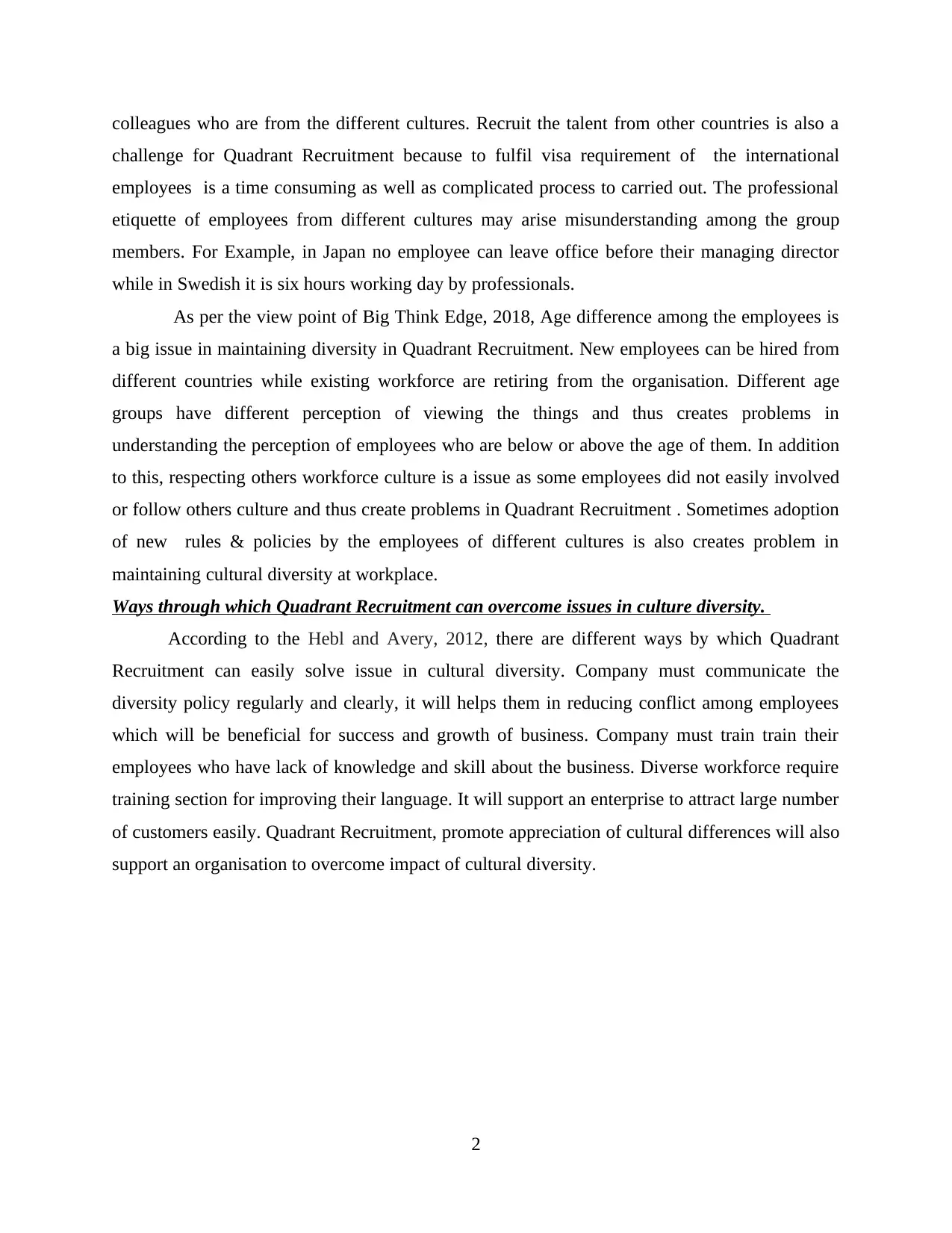
colleagues who are from the different cultures. Recruit the talent from other countries is also a
challenge for Quadrant Recruitment because to fulfil visa requirement of the international
employees is a time consuming as well as complicated process to carried out. The professional
etiquette of employees from different cultures may arise misunderstanding among the group
members. For Example, in Japan no employee can leave office before their managing director
while in Swedish it is six hours working day by professionals.
As per the view point of Big Think Edge, 2018, Age difference among the employees is
a big issue in maintaining diversity in Quadrant Recruitment. New employees can be hired from
different countries while existing workforce are retiring from the organisation. Different age
groups have different perception of viewing the things and thus creates problems in
understanding the perception of employees who are below or above the age of them. In addition
to this, respecting others workforce culture is a issue as some employees did not easily involved
or follow others culture and thus create problems in Quadrant Recruitment . Sometimes adoption
of new rules & policies by the employees of different cultures is also creates problem in
maintaining cultural diversity at workplace.
Ways through which Quadrant Recruitment can overcome issues in culture diversity.
According to the Hebl and Avery, 2012, there are different ways by which Quadrant
Recruitment can easily solve issue in cultural diversity. Company must communicate the
diversity policy regularly and clearly, it will helps them in reducing conflict among employees
which will be beneficial for success and growth of business. Company must train train their
employees who have lack of knowledge and skill about the business. Diverse workforce require
training section for improving their language. It will support an enterprise to attract large number
of customers easily. Quadrant Recruitment, promote appreciation of cultural differences will also
support an organisation to overcome impact of cultural diversity.
2
challenge for Quadrant Recruitment because to fulfil visa requirement of the international
employees is a time consuming as well as complicated process to carried out. The professional
etiquette of employees from different cultures may arise misunderstanding among the group
members. For Example, in Japan no employee can leave office before their managing director
while in Swedish it is six hours working day by professionals.
As per the view point of Big Think Edge, 2018, Age difference among the employees is
a big issue in maintaining diversity in Quadrant Recruitment. New employees can be hired from
different countries while existing workforce are retiring from the organisation. Different age
groups have different perception of viewing the things and thus creates problems in
understanding the perception of employees who are below or above the age of them. In addition
to this, respecting others workforce culture is a issue as some employees did not easily involved
or follow others culture and thus create problems in Quadrant Recruitment . Sometimes adoption
of new rules & policies by the employees of different cultures is also creates problem in
maintaining cultural diversity at workplace.
Ways through which Quadrant Recruitment can overcome issues in culture diversity.
According to the Hebl and Avery, 2012, there are different ways by which Quadrant
Recruitment can easily solve issue in cultural diversity. Company must communicate the
diversity policy regularly and clearly, it will helps them in reducing conflict among employees
which will be beneficial for success and growth of business. Company must train train their
employees who have lack of knowledge and skill about the business. Diverse workforce require
training section for improving their language. It will support an enterprise to attract large number
of customers easily. Quadrant Recruitment, promote appreciation of cultural differences will also
support an organisation to overcome impact of cultural diversity.
2
Paraphrase This Document
Need a fresh take? Get an instant paraphrase of this document with our AI Paraphraser
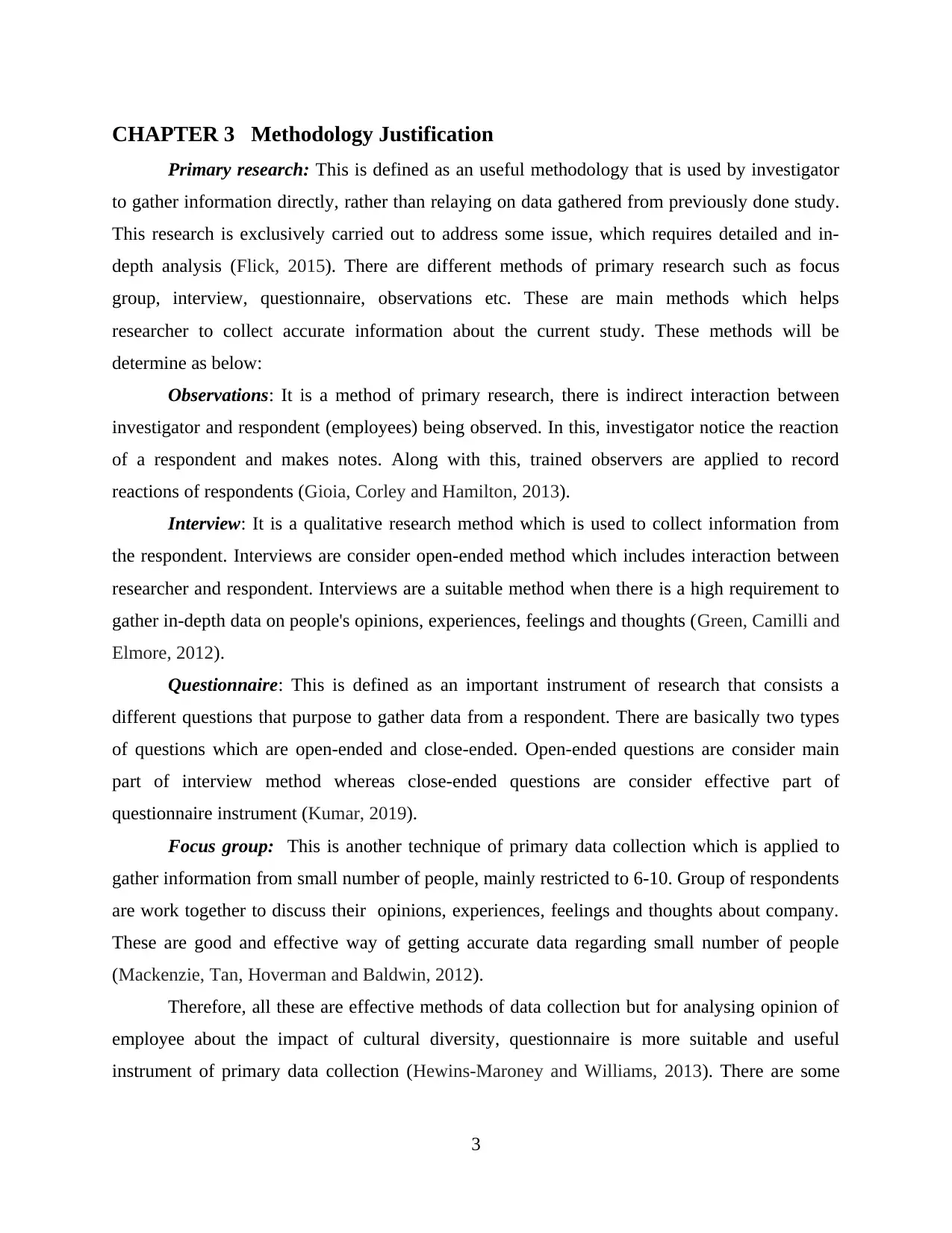
CHAPTER 3 Methodology Justification
Primary research: This is defined as an useful methodology that is used by investigator
to gather information directly, rather than relaying on data gathered from previously done study.
This research is exclusively carried out to address some issue, which requires detailed and in-
depth analysis (Flick, 2015). There are different methods of primary research such as focus
group, interview, questionnaire, observations etc. These are main methods which helps
researcher to collect accurate information about the current study. These methods will be
determine as below:
Observations: It is a method of primary research, there is indirect interaction between
investigator and respondent (employees) being observed. In this, investigator notice the reaction
of a respondent and makes notes. Along with this, trained observers are applied to record
reactions of respondents (Gioia, Corley and Hamilton, 2013).
Interview: It is a qualitative research method which is used to collect information from
the respondent. Interviews are consider open-ended method which includes interaction between
researcher and respondent. Interviews are a suitable method when there is a high requirement to
gather in-depth data on people's opinions, experiences, feelings and thoughts (Green, Camilli and
Elmore, 2012).
Questionnaire: This is defined as an important instrument of research that consists a
different questions that purpose to gather data from a respondent. There are basically two types
of questions which are open-ended and close-ended. Open-ended questions are consider main
part of interview method whereas close-ended questions are consider effective part of
questionnaire instrument (Kumar, 2019).
Focus group: This is another technique of primary data collection which is applied to
gather information from small number of people, mainly restricted to 6-10. Group of respondents
are work together to discuss their opinions, experiences, feelings and thoughts about company.
These are good and effective way of getting accurate data regarding small number of people
(Mackenzie, Tan, Hoverman and Baldwin, 2012).
Therefore, all these are effective methods of data collection but for analysing opinion of
employee about the impact of cultural diversity, questionnaire is more suitable and useful
instrument of primary data collection (Hewins-Maroney and Williams, 2013). There are some
3
Primary research: This is defined as an useful methodology that is used by investigator
to gather information directly, rather than relaying on data gathered from previously done study.
This research is exclusively carried out to address some issue, which requires detailed and in-
depth analysis (Flick, 2015). There are different methods of primary research such as focus
group, interview, questionnaire, observations etc. These are main methods which helps
researcher to collect accurate information about the current study. These methods will be
determine as below:
Observations: It is a method of primary research, there is indirect interaction between
investigator and respondent (employees) being observed. In this, investigator notice the reaction
of a respondent and makes notes. Along with this, trained observers are applied to record
reactions of respondents (Gioia, Corley and Hamilton, 2013).
Interview: It is a qualitative research method which is used to collect information from
the respondent. Interviews are consider open-ended method which includes interaction between
researcher and respondent. Interviews are a suitable method when there is a high requirement to
gather in-depth data on people's opinions, experiences, feelings and thoughts (Green, Camilli and
Elmore, 2012).
Questionnaire: This is defined as an important instrument of research that consists a
different questions that purpose to gather data from a respondent. There are basically two types
of questions which are open-ended and close-ended. Open-ended questions are consider main
part of interview method whereas close-ended questions are consider effective part of
questionnaire instrument (Kumar, 2019).
Focus group: This is another technique of primary data collection which is applied to
gather information from small number of people, mainly restricted to 6-10. Group of respondents
are work together to discuss their opinions, experiences, feelings and thoughts about company.
These are good and effective way of getting accurate data regarding small number of people
(Mackenzie, Tan, Hoverman and Baldwin, 2012).
Therefore, all these are effective methods of data collection but for analysing opinion of
employee about the impact of cultural diversity, questionnaire is more suitable and useful
instrument of primary data collection (Hewins-Maroney and Williams, 2013). There are some
3
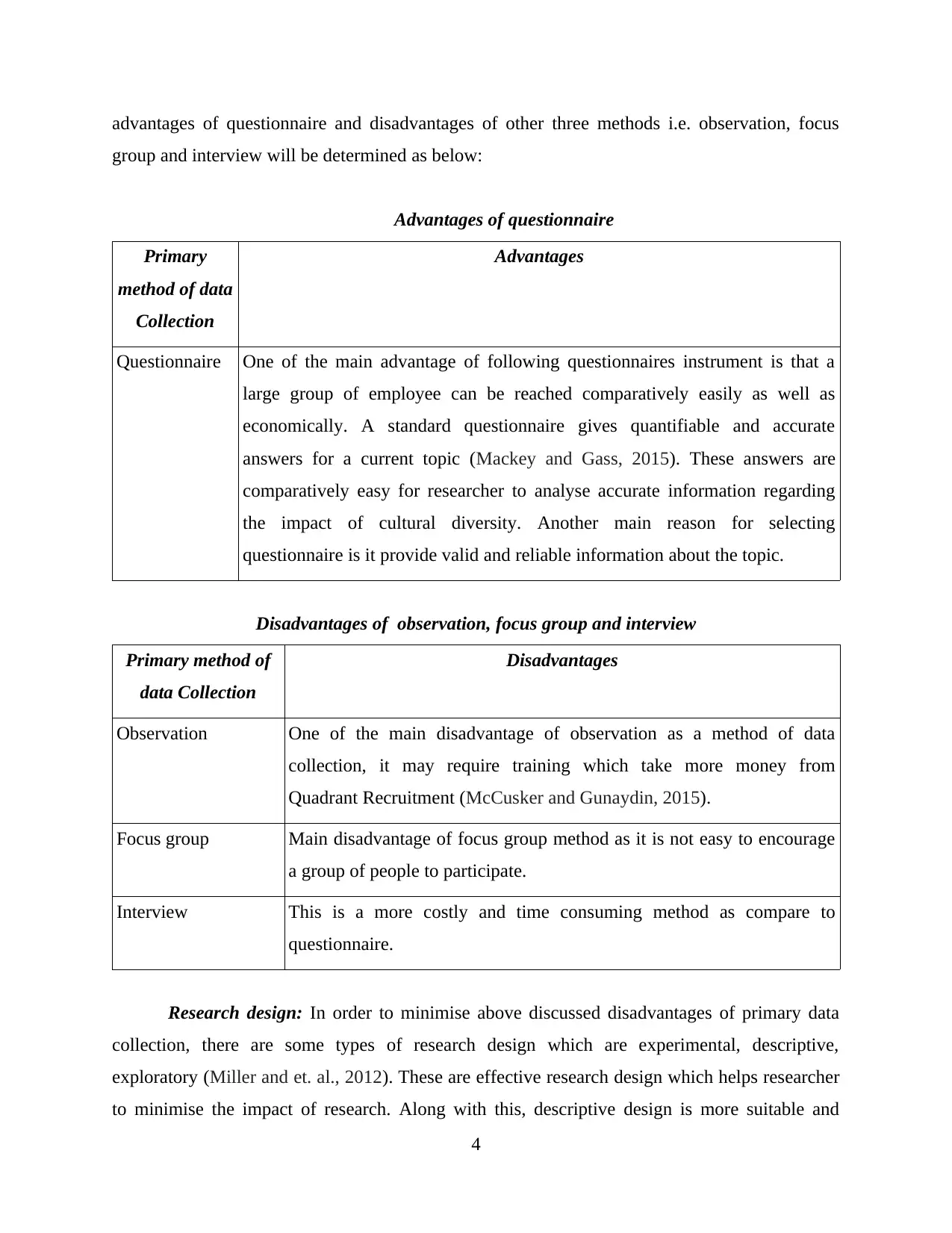
advantages of questionnaire and disadvantages of other three methods i.e. observation, focus
group and interview will be determined as below:
Advantages of questionnaire
Primary
method of data
Collection
Advantages
Questionnaire One of the main advantage of following questionnaires instrument is that a
large group of employee can be reached comparatively easily as well as
economically. A standard questionnaire gives quantifiable and accurate
answers for a current topic (Mackey and Gass, 2015). These answers are
comparatively easy for researcher to analyse accurate information regarding
the impact of cultural diversity. Another main reason for selecting
questionnaire is it provide valid and reliable information about the topic.
Disadvantages of observation, focus group and interview
Primary method of
data Collection
Disadvantages
Observation One of the main disadvantage of observation as a method of data
collection, it may require training which take more money from
Quadrant Recruitment (McCusker and Gunaydin, 2015).
Focus group Main disadvantage of focus group method as it is not easy to encourage
a group of people to participate.
Interview This is a more costly and time consuming method as compare to
questionnaire.
Research design: In order to minimise above discussed disadvantages of primary data
collection, there are some types of research design which are experimental, descriptive,
exploratory (Miller and et. al., 2012). These are effective research design which helps researcher
to minimise the impact of research. Along with this, descriptive design is more suitable and
4
group and interview will be determined as below:
Advantages of questionnaire
Primary
method of data
Collection
Advantages
Questionnaire One of the main advantage of following questionnaires instrument is that a
large group of employee can be reached comparatively easily as well as
economically. A standard questionnaire gives quantifiable and accurate
answers for a current topic (Mackey and Gass, 2015). These answers are
comparatively easy for researcher to analyse accurate information regarding
the impact of cultural diversity. Another main reason for selecting
questionnaire is it provide valid and reliable information about the topic.
Disadvantages of observation, focus group and interview
Primary method of
data Collection
Disadvantages
Observation One of the main disadvantage of observation as a method of data
collection, it may require training which take more money from
Quadrant Recruitment (McCusker and Gunaydin, 2015).
Focus group Main disadvantage of focus group method as it is not easy to encourage
a group of people to participate.
Interview This is a more costly and time consuming method as compare to
questionnaire.
Research design: In order to minimise above discussed disadvantages of primary data
collection, there are some types of research design which are experimental, descriptive,
exploratory (Miller and et. al., 2012). These are effective research design which helps researcher
to minimise the impact of research. Along with this, descriptive design is more suitable and
4
⊘ This is a preview!⊘
Do you want full access?
Subscribe today to unlock all pages.

Trusted by 1+ million students worldwide
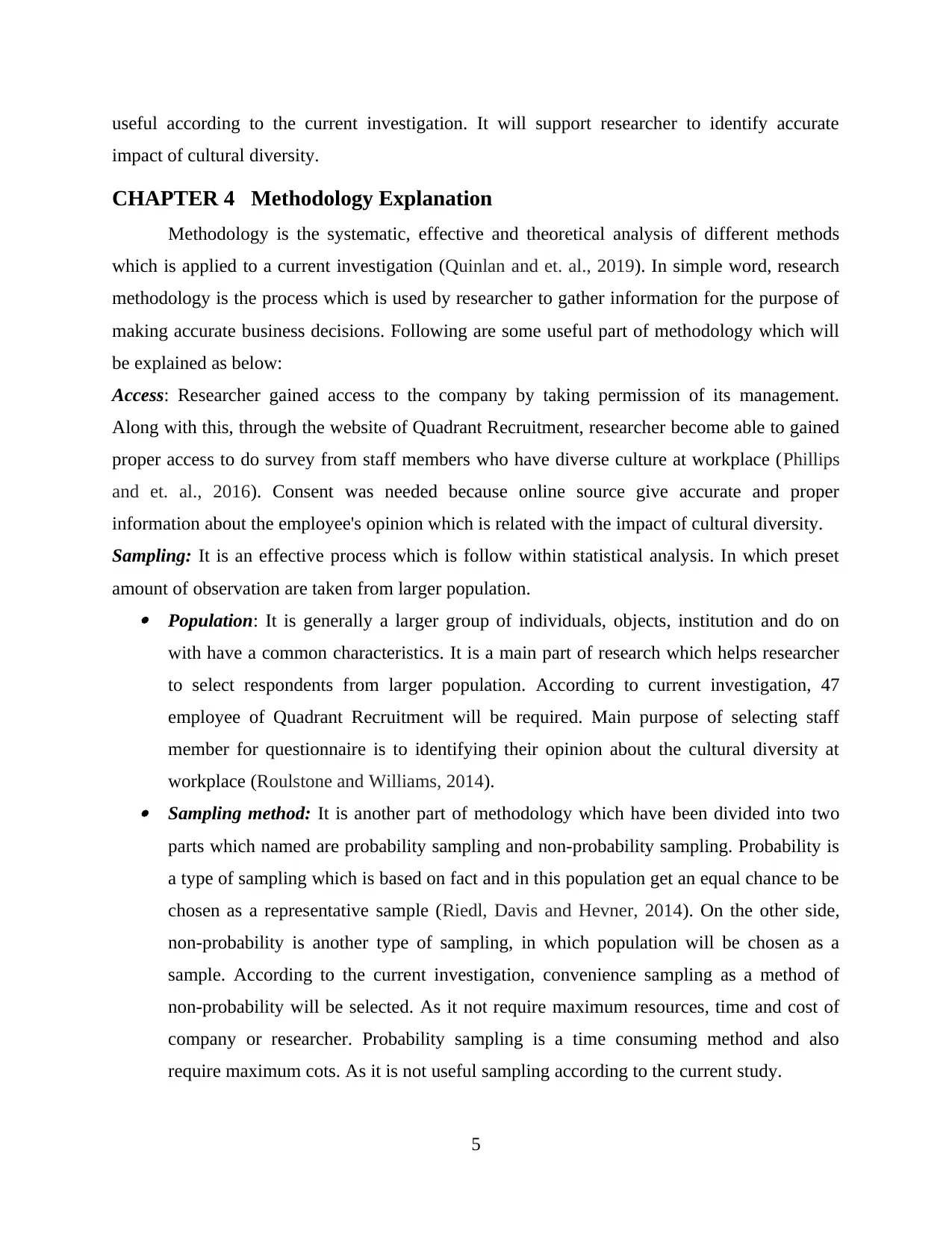
useful according to the current investigation. It will support researcher to identify accurate
impact of cultural diversity.
CHAPTER 4 Methodology Explanation
Methodology is the systematic, effective and theoretical analysis of different methods
which is applied to a current investigation (Quinlan and et. al., 2019). In simple word, research
methodology is the process which is used by researcher to gather information for the purpose of
making accurate business decisions. Following are some useful part of methodology which will
be explained as below:
Access: Researcher gained access to the company by taking permission of its management.
Along with this, through the website of Quadrant Recruitment, researcher become able to gained
proper access to do survey from staff members who have diverse culture at workplace (Phillips
and et. al., 2016). Consent was needed because online source give accurate and proper
information about the employee's opinion which is related with the impact of cultural diversity.
Sampling: It is an effective process which is follow within statistical analysis. In which preset
amount of observation are taken from larger population. Population: It is generally a larger group of individuals, objects, institution and do on
with have a common characteristics. It is a main part of research which helps researcher
to select respondents from larger population. According to current investigation, 47
employee of Quadrant Recruitment will be required. Main purpose of selecting staff
member for questionnaire is to identifying their opinion about the cultural diversity at
workplace (Roulstone and Williams, 2014). Sampling method: It is another part of methodology which have been divided into two
parts which named are probability sampling and non-probability sampling. Probability is
a type of sampling which is based on fact and in this population get an equal chance to be
chosen as a representative sample (Riedl, Davis and Hevner, 2014). On the other side,
non-probability is another type of sampling, in which population will be chosen as a
sample. According to the current investigation, convenience sampling as a method of
non-probability will be selected. As it not require maximum resources, time and cost of
company or researcher. Probability sampling is a time consuming method and also
require maximum cots. As it is not useful sampling according to the current study.
5
impact of cultural diversity.
CHAPTER 4 Methodology Explanation
Methodology is the systematic, effective and theoretical analysis of different methods
which is applied to a current investigation (Quinlan and et. al., 2019). In simple word, research
methodology is the process which is used by researcher to gather information for the purpose of
making accurate business decisions. Following are some useful part of methodology which will
be explained as below:
Access: Researcher gained access to the company by taking permission of its management.
Along with this, through the website of Quadrant Recruitment, researcher become able to gained
proper access to do survey from staff members who have diverse culture at workplace (Phillips
and et. al., 2016). Consent was needed because online source give accurate and proper
information about the employee's opinion which is related with the impact of cultural diversity.
Sampling: It is an effective process which is follow within statistical analysis. In which preset
amount of observation are taken from larger population. Population: It is generally a larger group of individuals, objects, institution and do on
with have a common characteristics. It is a main part of research which helps researcher
to select respondents from larger population. According to current investigation, 47
employee of Quadrant Recruitment will be required. Main purpose of selecting staff
member for questionnaire is to identifying their opinion about the cultural diversity at
workplace (Roulstone and Williams, 2014). Sampling method: It is another part of methodology which have been divided into two
parts which named are probability sampling and non-probability sampling. Probability is
a type of sampling which is based on fact and in this population get an equal chance to be
chosen as a representative sample (Riedl, Davis and Hevner, 2014). On the other side,
non-probability is another type of sampling, in which population will be chosen as a
sample. According to the current investigation, convenience sampling as a method of
non-probability will be selected. As it not require maximum resources, time and cost of
company or researcher. Probability sampling is a time consuming method and also
require maximum cots. As it is not useful sampling according to the current study.
5
Paraphrase This Document
Need a fresh take? Get an instant paraphrase of this document with our AI Paraphraser
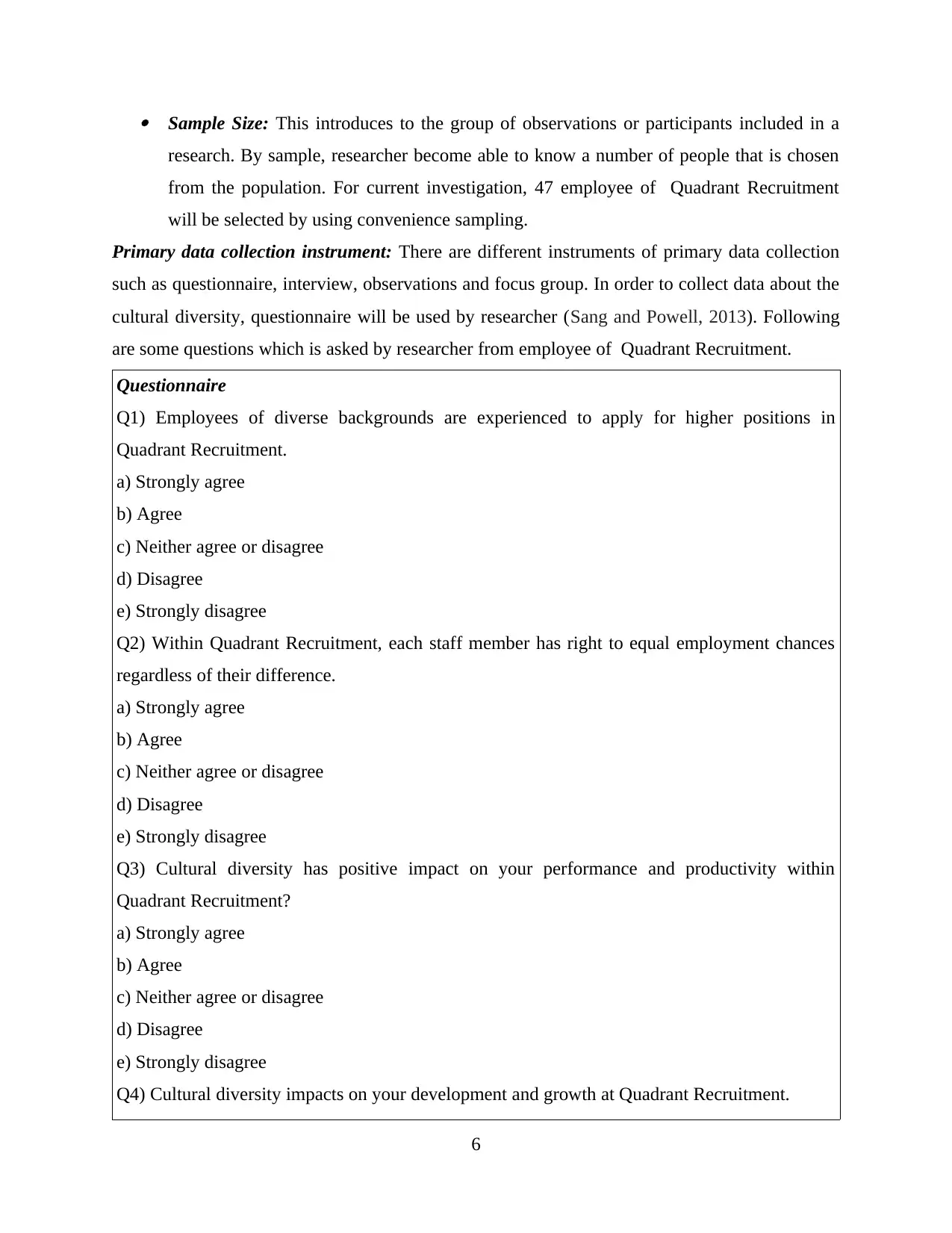
Sample Size: This introduces to the group of observations or participants included in a
research. By sample, researcher become able to know a number of people that is chosen
from the population. For current investigation, 47 employee of Quadrant Recruitment
will be selected by using convenience sampling.
Primary data collection instrument: There are different instruments of primary data collection
such as questionnaire, interview, observations and focus group. In order to collect data about the
cultural diversity, questionnaire will be used by researcher (Sang and Powell, 2013). Following
are some questions which is asked by researcher from employee of Quadrant Recruitment.
Questionnaire
Q1) Employees of diverse backgrounds are experienced to apply for higher positions in
Quadrant Recruitment.
a) Strongly agree
b) Agree
c) Neither agree or disagree
d) Disagree
e) Strongly disagree
Q2) Within Quadrant Recruitment, each staff member has right to equal employment chances
regardless of their difference.
a) Strongly agree
b) Agree
c) Neither agree or disagree
d) Disagree
e) Strongly disagree
Q3) Cultural diversity has positive impact on your performance and productivity within
Quadrant Recruitment?
a) Strongly agree
b) Agree
c) Neither agree or disagree
d) Disagree
e) Strongly disagree
Q4) Cultural diversity impacts on your development and growth at Quadrant Recruitment.
6
research. By sample, researcher become able to know a number of people that is chosen
from the population. For current investigation, 47 employee of Quadrant Recruitment
will be selected by using convenience sampling.
Primary data collection instrument: There are different instruments of primary data collection
such as questionnaire, interview, observations and focus group. In order to collect data about the
cultural diversity, questionnaire will be used by researcher (Sang and Powell, 2013). Following
are some questions which is asked by researcher from employee of Quadrant Recruitment.
Questionnaire
Q1) Employees of diverse backgrounds are experienced to apply for higher positions in
Quadrant Recruitment.
a) Strongly agree
b) Agree
c) Neither agree or disagree
d) Disagree
e) Strongly disagree
Q2) Within Quadrant Recruitment, each staff member has right to equal employment chances
regardless of their difference.
a) Strongly agree
b) Agree
c) Neither agree or disagree
d) Disagree
e) Strongly disagree
Q3) Cultural diversity has positive impact on your performance and productivity within
Quadrant Recruitment?
a) Strongly agree
b) Agree
c) Neither agree or disagree
d) Disagree
e) Strongly disagree
Q4) Cultural diversity impacts on your development and growth at Quadrant Recruitment.
6
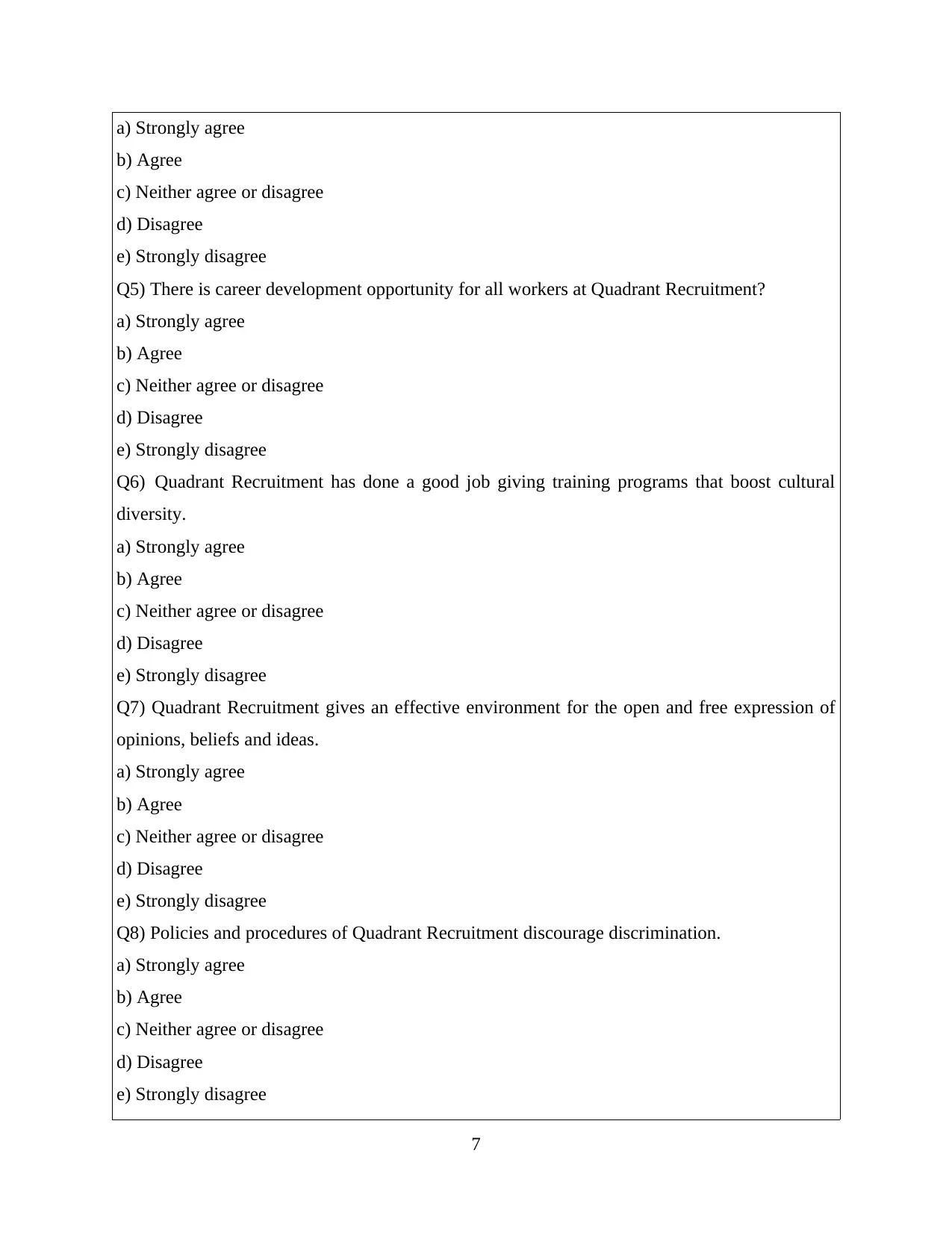
a) Strongly agree
b) Agree
c) Neither agree or disagree
d) Disagree
e) Strongly disagree
Q5) There is career development opportunity for all workers at Quadrant Recruitment?
a) Strongly agree
b) Agree
c) Neither agree or disagree
d) Disagree
e) Strongly disagree
Q6) Quadrant Recruitment has done a good job giving training programs that boost cultural
diversity.
a) Strongly agree
b) Agree
c) Neither agree or disagree
d) Disagree
e) Strongly disagree
Q7) Quadrant Recruitment gives an effective environment for the open and free expression of
opinions, beliefs and ideas.
a) Strongly agree
b) Agree
c) Neither agree or disagree
d) Disagree
e) Strongly disagree
Q8) Policies and procedures of Quadrant Recruitment discourage discrimination.
a) Strongly agree
b) Agree
c) Neither agree or disagree
d) Disagree
e) Strongly disagree
7
b) Agree
c) Neither agree or disagree
d) Disagree
e) Strongly disagree
Q5) There is career development opportunity for all workers at Quadrant Recruitment?
a) Strongly agree
b) Agree
c) Neither agree or disagree
d) Disagree
e) Strongly disagree
Q6) Quadrant Recruitment has done a good job giving training programs that boost cultural
diversity.
a) Strongly agree
b) Agree
c) Neither agree or disagree
d) Disagree
e) Strongly disagree
Q7) Quadrant Recruitment gives an effective environment for the open and free expression of
opinions, beliefs and ideas.
a) Strongly agree
b) Agree
c) Neither agree or disagree
d) Disagree
e) Strongly disagree
Q8) Policies and procedures of Quadrant Recruitment discourage discrimination.
a) Strongly agree
b) Agree
c) Neither agree or disagree
d) Disagree
e) Strongly disagree
7
⊘ This is a preview!⊘
Do you want full access?
Subscribe today to unlock all pages.

Trusted by 1+ million students worldwide
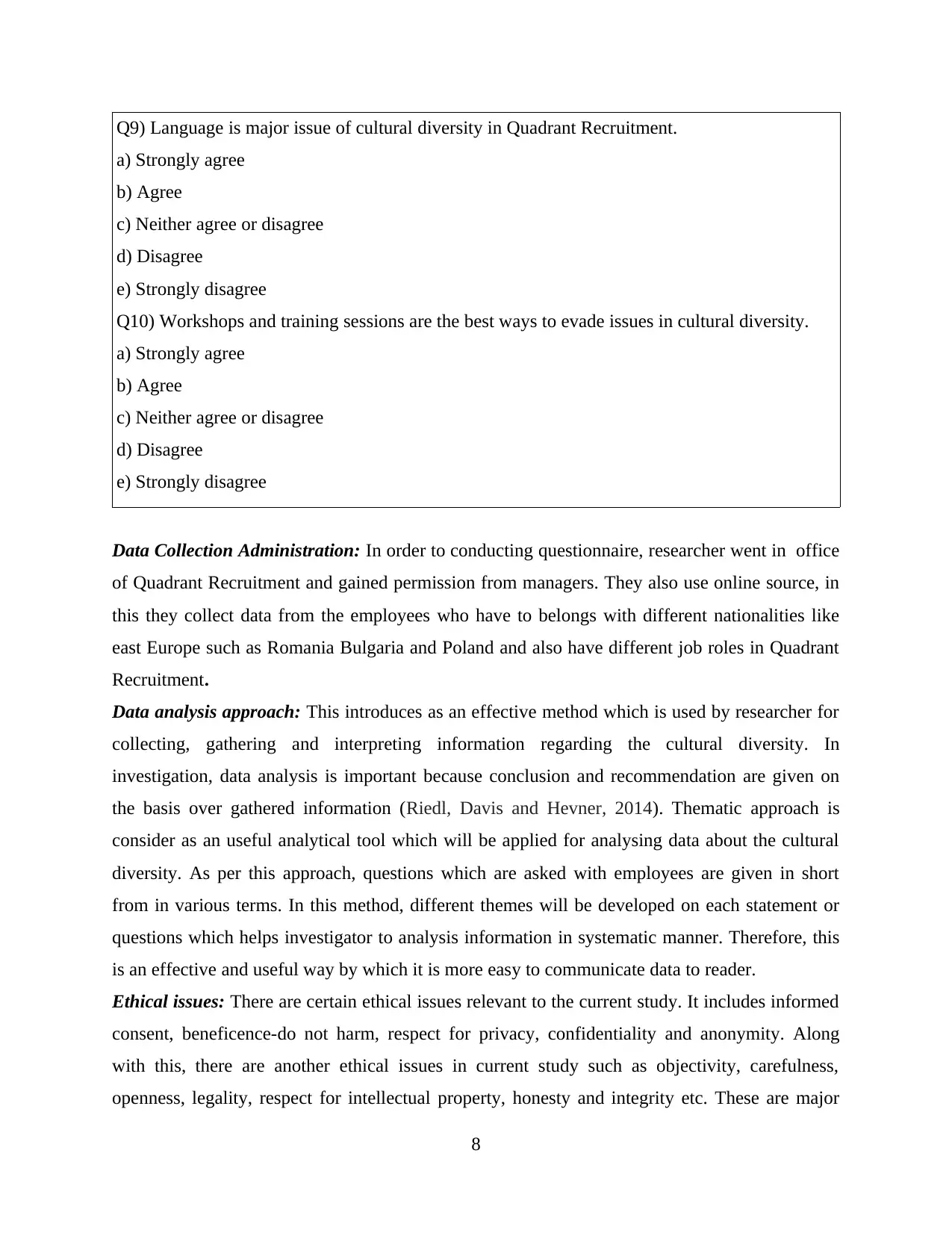
Q9) Language is major issue of cultural diversity in Quadrant Recruitment.
a) Strongly agree
b) Agree
c) Neither agree or disagree
d) Disagree
e) Strongly disagree
Q10) Workshops and training sessions are the best ways to evade issues in cultural diversity.
a) Strongly agree
b) Agree
c) Neither agree or disagree
d) Disagree
e) Strongly disagree
Data Collection Administration: In order to conducting questionnaire, researcher went in office
of Quadrant Recruitment and gained permission from managers. They also use online source, in
this they collect data from the employees who have to belongs with different nationalities like
east Europe such as Romania Bulgaria and Poland and also have different job roles in Quadrant
Recruitment.
Data analysis approach: This introduces as an effective method which is used by researcher for
collecting, gathering and interpreting information regarding the cultural diversity. In
investigation, data analysis is important because conclusion and recommendation are given on
the basis over gathered information (Riedl, Davis and Hevner, 2014). Thematic approach is
consider as an useful analytical tool which will be applied for analysing data about the cultural
diversity. As per this approach, questions which are asked with employees are given in short
from in various terms. In this method, different themes will be developed on each statement or
questions which helps investigator to analysis information in systematic manner. Therefore, this
is an effective and useful way by which it is more easy to communicate data to reader.
Ethical issues: There are certain ethical issues relevant to the current study. It includes informed
consent, beneficence-do not harm, respect for privacy, confidentiality and anonymity. Along
with this, there are another ethical issues in current study such as objectivity, carefulness,
openness, legality, respect for intellectual property, honesty and integrity etc. These are major
8
a) Strongly agree
b) Agree
c) Neither agree or disagree
d) Disagree
e) Strongly disagree
Q10) Workshops and training sessions are the best ways to evade issues in cultural diversity.
a) Strongly agree
b) Agree
c) Neither agree or disagree
d) Disagree
e) Strongly disagree
Data Collection Administration: In order to conducting questionnaire, researcher went in office
of Quadrant Recruitment and gained permission from managers. They also use online source, in
this they collect data from the employees who have to belongs with different nationalities like
east Europe such as Romania Bulgaria and Poland and also have different job roles in Quadrant
Recruitment.
Data analysis approach: This introduces as an effective method which is used by researcher for
collecting, gathering and interpreting information regarding the cultural diversity. In
investigation, data analysis is important because conclusion and recommendation are given on
the basis over gathered information (Riedl, Davis and Hevner, 2014). Thematic approach is
consider as an useful analytical tool which will be applied for analysing data about the cultural
diversity. As per this approach, questions which are asked with employees are given in short
from in various terms. In this method, different themes will be developed on each statement or
questions which helps investigator to analysis information in systematic manner. Therefore, this
is an effective and useful way by which it is more easy to communicate data to reader.
Ethical issues: There are certain ethical issues relevant to the current study. It includes informed
consent, beneficence-do not harm, respect for privacy, confidentiality and anonymity. Along
with this, there are another ethical issues in current study such as objectivity, carefulness,
openness, legality, respect for intellectual property, honesty and integrity etc. These are major
8
Paraphrase This Document
Need a fresh take? Get an instant paraphrase of this document with our AI Paraphraser
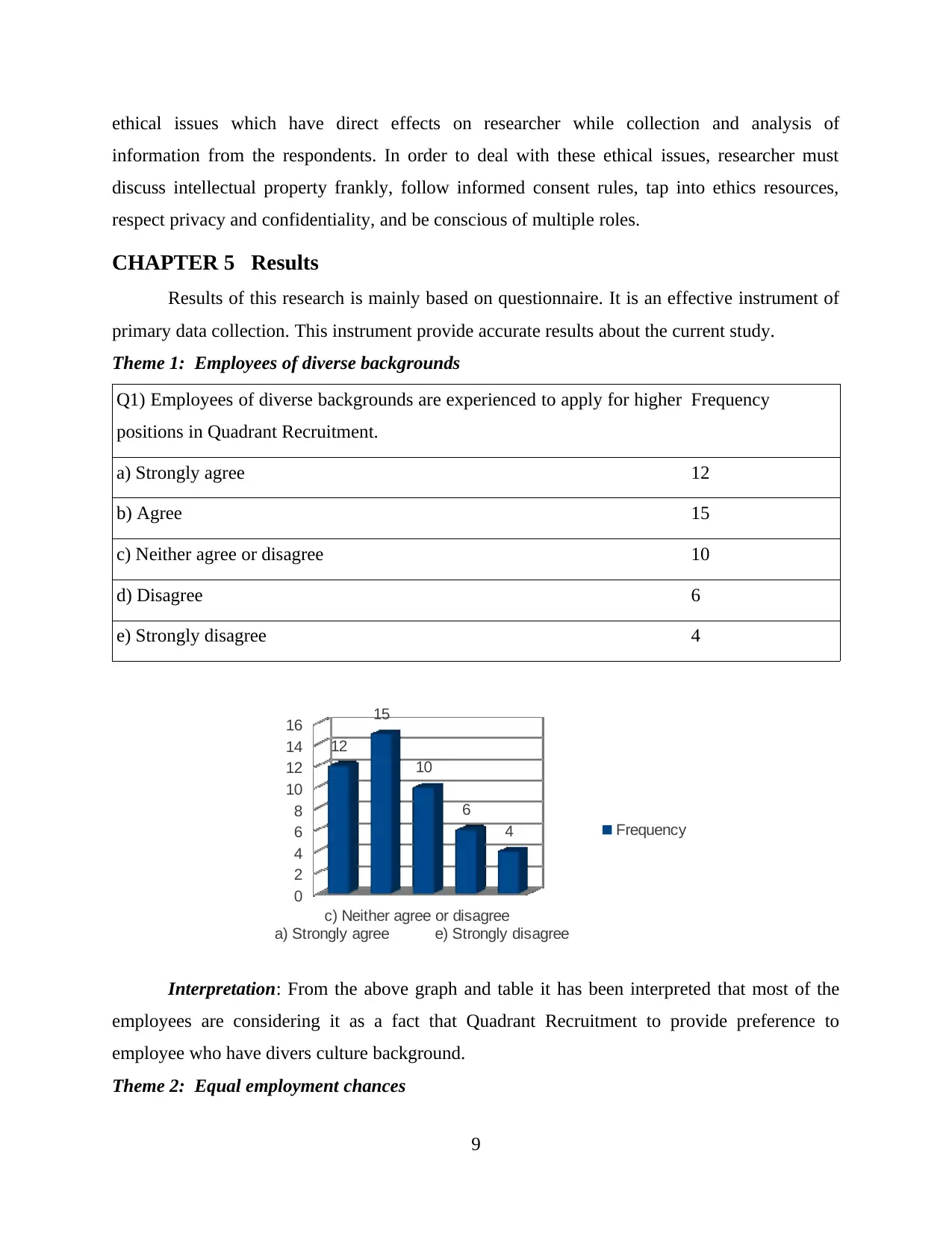
ethical issues which have direct effects on researcher while collection and analysis of
information from the respondents. In order to deal with these ethical issues, researcher must
discuss intellectual property frankly, follow informed consent rules, tap into ethics resources,
respect privacy and confidentiality, and be conscious of multiple roles.
CHAPTER 5 Results
Results of this research is mainly based on questionnaire. It is an effective instrument of
primary data collection. This instrument provide accurate results about the current study.
Theme 1: Employees of diverse backgrounds
Q1) Employees of diverse backgrounds are experienced to apply for higher
positions in Quadrant Recruitment.
Frequency
a) Strongly agree 12
b) Agree 15
c) Neither agree or disagree 10
d) Disagree 6
e) Strongly disagree 4
a) Strongly agree
c) Neither agree or disagree
e) Strongly disagree
0
2
4
6
8
10
12
14
16
12
15
10
6
4 Frequency
Interpretation: From the above graph and table it has been interpreted that most of the
employees are considering it as a fact that Quadrant Recruitment to provide preference to
employee who have divers culture background.
Theme 2: Equal employment chances
9
information from the respondents. In order to deal with these ethical issues, researcher must
discuss intellectual property frankly, follow informed consent rules, tap into ethics resources,
respect privacy and confidentiality, and be conscious of multiple roles.
CHAPTER 5 Results
Results of this research is mainly based on questionnaire. It is an effective instrument of
primary data collection. This instrument provide accurate results about the current study.
Theme 1: Employees of diverse backgrounds
Q1) Employees of diverse backgrounds are experienced to apply for higher
positions in Quadrant Recruitment.
Frequency
a) Strongly agree 12
b) Agree 15
c) Neither agree or disagree 10
d) Disagree 6
e) Strongly disagree 4
a) Strongly agree
c) Neither agree or disagree
e) Strongly disagree
0
2
4
6
8
10
12
14
16
12
15
10
6
4 Frequency
Interpretation: From the above graph and table it has been interpreted that most of the
employees are considering it as a fact that Quadrant Recruitment to provide preference to
employee who have divers culture background.
Theme 2: Equal employment chances
9
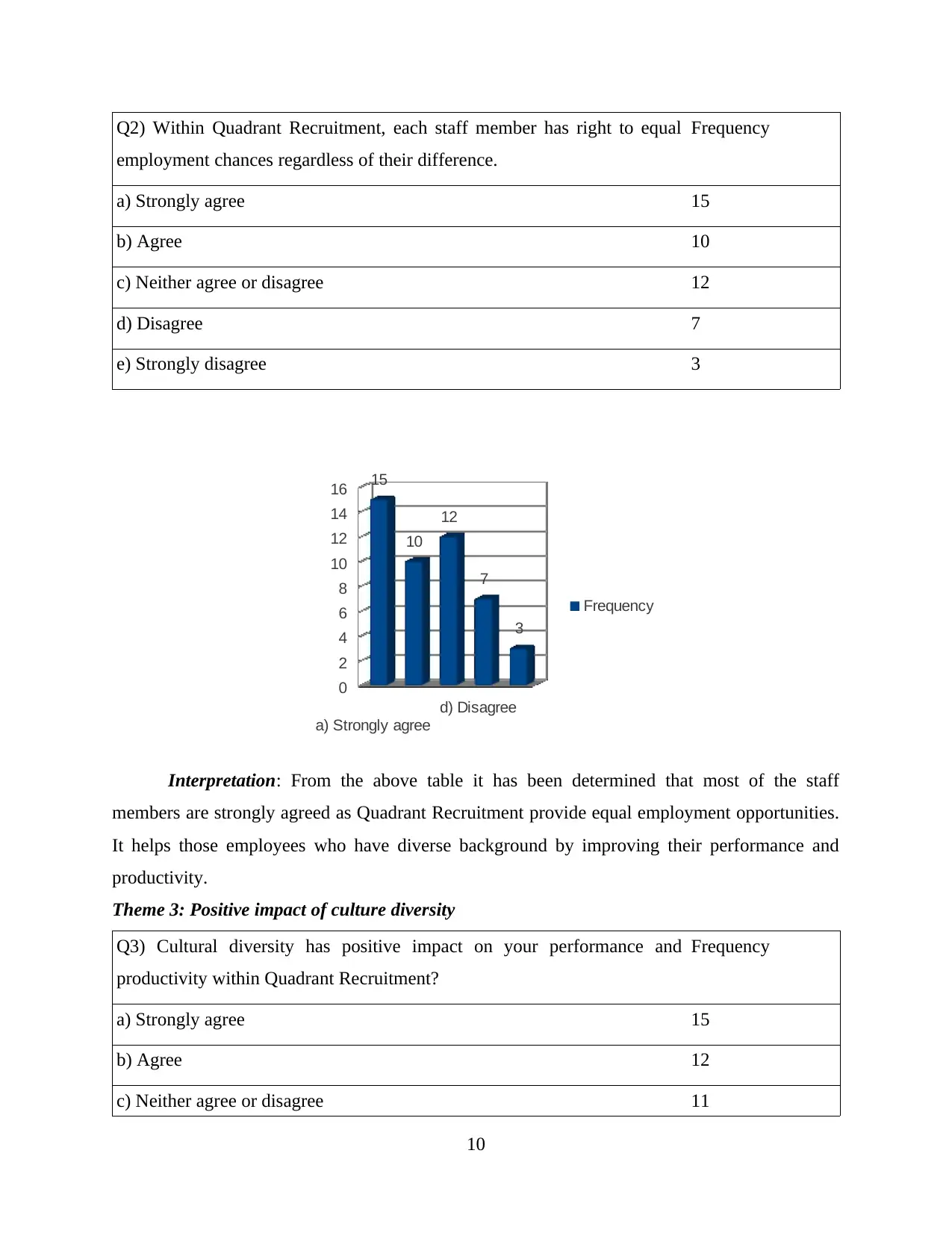
Q2) Within Quadrant Recruitment, each staff member has right to equal
employment chances regardless of their difference.
Frequency
a) Strongly agree 15
b) Agree 10
c) Neither agree or disagree 12
d) Disagree 7
e) Strongly disagree 3
a) Strongly agree
d) Disagree
0
2
4
6
8
10
12
14
16 15
10
12
7
3
Frequency
Interpretation: From the above table it has been determined that most of the staff
members are strongly agreed as Quadrant Recruitment provide equal employment opportunities.
It helps those employees who have diverse background by improving their performance and
productivity.
Theme 3: Positive impact of culture diversity
Q3) Cultural diversity has positive impact on your performance and
productivity within Quadrant Recruitment?
Frequency
a) Strongly agree 15
b) Agree 12
c) Neither agree or disagree 11
10
employment chances regardless of their difference.
Frequency
a) Strongly agree 15
b) Agree 10
c) Neither agree or disagree 12
d) Disagree 7
e) Strongly disagree 3
a) Strongly agree
d) Disagree
0
2
4
6
8
10
12
14
16 15
10
12
7
3
Frequency
Interpretation: From the above table it has been determined that most of the staff
members are strongly agreed as Quadrant Recruitment provide equal employment opportunities.
It helps those employees who have diverse background by improving their performance and
productivity.
Theme 3: Positive impact of culture diversity
Q3) Cultural diversity has positive impact on your performance and
productivity within Quadrant Recruitment?
Frequency
a) Strongly agree 15
b) Agree 12
c) Neither agree or disagree 11
10
⊘ This is a preview!⊘
Do you want full access?
Subscribe today to unlock all pages.

Trusted by 1+ million students worldwide
1 out of 21
Related Documents
Your All-in-One AI-Powered Toolkit for Academic Success.
+13062052269
info@desklib.com
Available 24*7 on WhatsApp / Email
![[object Object]](/_next/static/media/star-bottom.7253800d.svg)
Unlock your academic potential
Copyright © 2020–2025 A2Z Services. All Rights Reserved. Developed and managed by ZUCOL.





